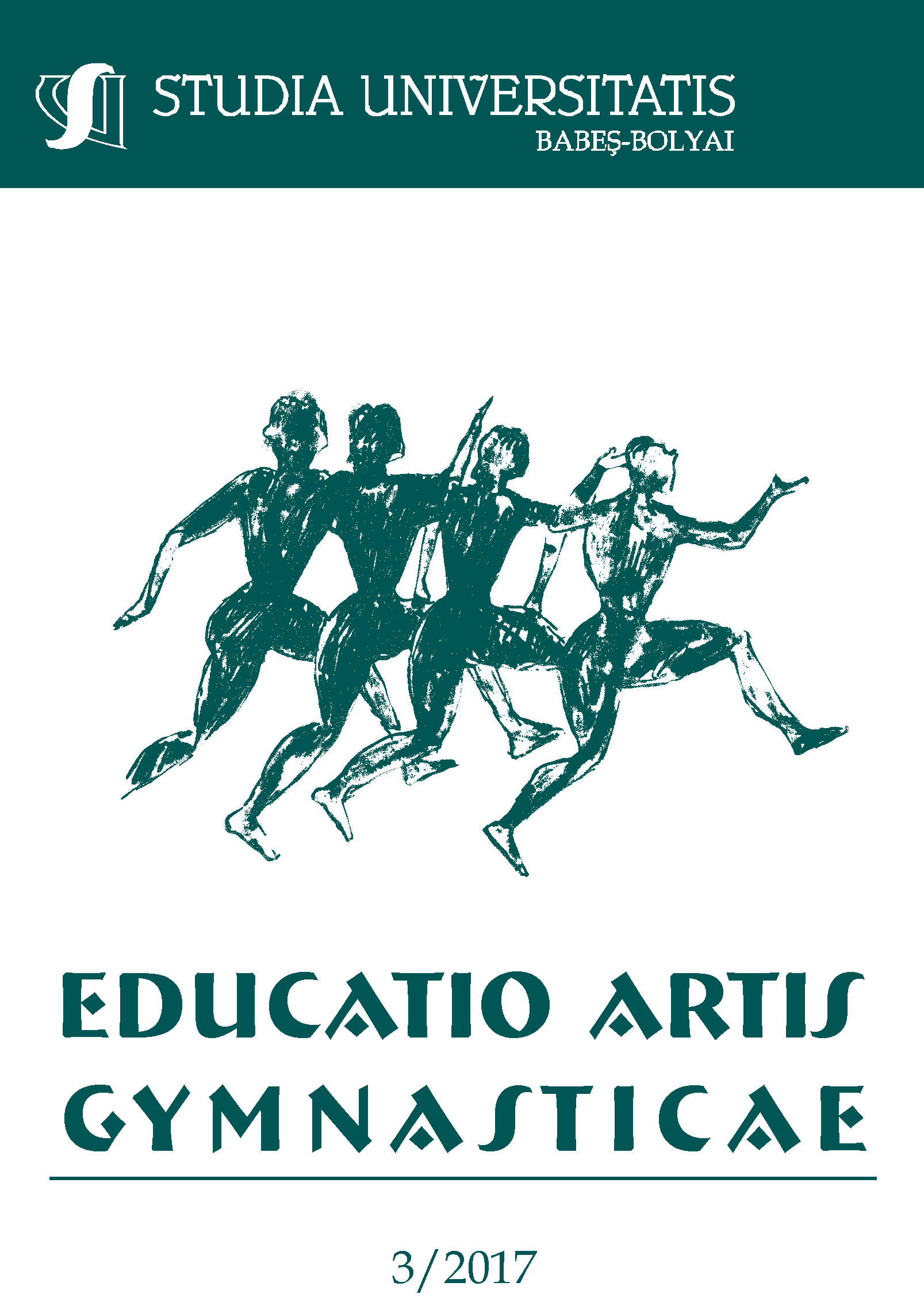FREQUENCY OF PRACTICING PHYSICAL AND SPORTS ACTIVITIES AND THE SELF-ESTEEM AT THE STUDENTS
DOI:
https://doi.org/10.24193/subbeag.62(3).25Keywords:
self-esteem; physical activity; gender; students; the frequency of physical activity.Abstract
In this paper we are looking at the influence of physical and sports activities on self-esteem among students from Babeş-Bolyai University in Cluj-Napoca. For this purpose, 465 questionnaires were applied to students from 13 faculties. Respondents were aged between 18 and 40, most of them aged 19-21. The statistical data was processed using the statistical analysis program SPSS 20, and for the graphic representations we used the Microsoft EXCELL 2007 version. Students' perception of their own person outlines a rather positive image of how they see themselves and esteem themselves. Analysis of a more frequent or rare participation in physical activity and sport that there is a significant difference between the mean scores of self-esteem measured on the entire sample. By gender, there was a distinction between girls and boys, data suggesting that girls who reported greater self-esteem are more often involved (several times a month or several times a week or daily) in motric activities, and the boys, just only those who practice very often (several times a week or daily) reported a greater self-esteem.
REZUMAT. Frecvența practicării activităților fizice și sportive și stima de sine la studenți. În lucrarea de față se urmărește influența pe care o are practicarea activităților fizice și sportive asupra stimei de sine în rândurile studenților din Universitatea Babeş-Bolyai din Cluj-Napoca. În acest scop au fost aplicate 465 de chestionare la studenți din 13 facultăți. Respondenții au avut vârsta cuprinsă între 18 și 40 de ani, majoritatea lor având vârsta cuprinsă între 19–21 de ani. Datele statistice au fost prelucrate cu ajutorul programului de analize statistice SPSS 20, iar pentru realizarea reprezentărilor grafice am folosit programul Microsoft EXCELL, versiunea 2007. Percepția studenților despre propria persoană conturează o imagine mai degrabă pozitivă legată de modul în care respondenții se autopercep și se stimează. Analiza influenței unei participări mai frecvente sau mai rare în activitățile fizice și sportive arată că există o diferență semnificativă între scorurile medii ale stimei de sine măsurate pe întregul eșantion. În funcție de sex, s-a constatat o diferențiere între fete și băieți, datele sugerând că fetele care au raportat o stimă de sine mai mare se implică mai frecvent (de câteva ori pe lună sau de câteva ori pe săptămână sau zilnic) în activități motrice, iar băieții doar cei care practică foarte frecvent (de câteva ori pe săptămână sau zilnic) au raportat o stimă de sine mult mai mare.
Cuvinte cheie: stima de sine; activități fizice; gen; studenți; frecvența practicării activităților fizice.
References
Bagley, C., Bolitho, F., Bertrand, L., (1997); Norms and Construct Validity of the Rosenberg Self-Esteem Scale in Canadian High School Populations: Implications for Counselling. Canadian Journal of Counselling, Vol. 31:1.
Baumeister, R.F., Campbell, J.D., Krueger, J.I., & Vohs, K.D. (2003). Does high self-esteem cause better performance, interpersonal success, happiness, or healthier lifestyles? Psychological Science in the Public Interest, 4, 1-44.
Bleidorn, W., Arslan, R.C., Denissen, J.J.A., Rentfrow, P.J., Gebauer, J.E., Potter, J., & Gosling, S.D. (2015, December 21). Age and Gender Differences in Self-Esteem—A Cross-Cultural Window. Journal of Personality and Social Psychology. Advance online publication. http://dx.doi.org/10.1037/pspp0000078
Bowker A., (2006); The Relationship Between Sports Participation and Self-Esteem During Early Adolescence, Canadian Journal of Behavioural Science, 38:2, pp.214-229.
Bowker A., Gadbois S., and Cornock B. (2003); Sports Participation and Self-Esteem: Variations as a Function of Gender and Gender Role Orientation. Sex Roles, Vol. 49, pp. 47-57.
Erkut S., Tracy A.J. (2002). Predicting Adolescent Self-Esteem from Participation in School Sports Among Latino Subgroups Hispanic, Journal of Behavioral Sciences, Vol. 24 No. 4, 409-429, DOI: 10.1177/0739986302238212
Frost, J.; McKelvie, S., J., (2005): The Relationship of Self-Esteem and Body Satisfaction to Exercise Activity for Male and Female Elementary School, High School, and University Students, Athletic Insight, Volume 7, Issue 4.
Gentile, B., Grabe, S., Dolan-Pascoe, B., Twenge, J.M., Wells, B.E., & Maitino, A. (2009). Gender differences in domain-specific self-esteem: A meta-analysis. Review of General Psychology, 13(1), 34.
Guidon, M.H. (2009). Self-Esteem Across the Lifespan: Issues and Interventions. Taylor & Francis, ISBN 0203884329, 9780203884324.
Heatherton, T.F. & Wyland, C. (2003). Assessing self-esteem. In S. Lopez and R. Snyder, (Eds). Assessing Positive Psychology. (pp. 219 – 233). Washington, DC: APA.
Ichraf, A., Ali, B.M., Khaled, T., Liwa, M., & Ali, E. (2013), „Effect of gender and type of sport on anxiety and self-esteem”. International Journal of Humanities and Social Science Invention ISSN (Online): 2319 – 7722, ISSN (Print): 2319 – 7714 www.ijhssi.org Volume 2 Issue 3, PP.55-61.
ISSP Research Group (2009): International Social Survey Programme: Leisure Time and Sports - ISSP 2007. GESIS Data Archive, Cologne. ZA4850 Data file Version 2.0.0, doi:10.4232/1.10079
Modrzejewska, R., Badura-Madej W., (2009); Change in self-image in the population of adolescents in 15 years – a comparative study. Archives of Psychiatry and Psychotherapy; 2: 41–47. Ómarsson, B., P., (2013); Effects of sports participation on adolescents self-esteem and body-image: differences in gender and types of sports explored, Bachelor's degrees Psychology.
Slutzky C.B., Simpkins S.D. (2009). The link between children’s sport participation and self-esteem: Exploring the mediating role of sport self-concept. Psychology of Sport and Exercise 10, 381-389.
Scarpa, S. (2011). Physical self-concept and self-esteem in adolescent and young adults with and without physical disability: The role of sport participation, European Journal of Adapted Physical Activity, 4(1), 38-53
Wagnsson, S., Lindwall, M., Gustafsson, H. (2014). Participation in Organized Sport and Self-Esteem across Adolescence: The Mediating Role of Perceived Sport Competence. Journal of Sport & Exercise Psychology; Vol. 36 Issue 6, pp. 584-594.
Downloads
Published
How to Cite
Issue
Section
License
Copyright (c) 2017 Studia Universitatis Babeș-Bolyai Educatio Artis Gymnasticae

This work is licensed under a Creative Commons Attribution-NonCommercial-NoDerivatives 4.0 International License.






